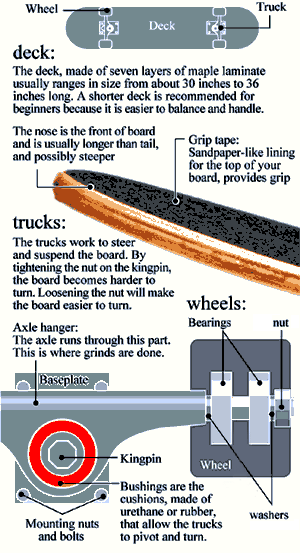 o
Skateboarding! o
Skateboarding!
Basic
how to guide and fundamentals of Skateboarding
Skateboard Anatomy

The Skateboard consists of four
major parts:
1. The Deck 2. Trucks 3.
Wheels 4. Grip Tape
The deck
(Skateboard, board)
- Length
- There are two general length
classifications of skateboard: Traditional/Street:
under 33 in; and Longboard; over 35 in
- Traditional decks are the most
common, and most versatile, while long boards
are generally used for cruising only and provide
the rider a very "surfy" feel
- Length choice is a purely personal
decision, although a general rule states that
smaller skaters should choose shorter boards (for
control)
- Width
- Street decks range between
7.5 in and 8.25 in, although some decks are wider
or narrower
- Width choice is also a purely
personal decision, although smaller skaters (especially
smaller footed skaters) will find a deck under
8 in makes it easier to learn tricks
- Concave
- Most decks (except for some
longboards) have a raised nose, tail, and sides.
This is called the concave.
- The depth and overall shape
of the concave has a dramatic effect on the response
of the skateboard to the skater
- The deeper the concave, the
more aggressive the skater can be with their tricks
- The shallower the concave,
the more forgiving the deck is for newer skaters
- Shape
Materials
- Wood
- The most common deck material
is wood
- Almost all wood deck skateboards
are made from Canadian Maple
- Each deck maker uses a varying
number of plys (layers), usually no less than
5 and no more than 9
- Plastic
- Some less expensive skateboards
utilize plastic for the deck. While this material
is cheaper and more durable than wood, it does
not offer the same responsivness.
- Other materials
- More recent materials of skateboard
design include aluminum and fiberglass/carbon
composites
- These materials are being used
to try to improve upon the durability of wood,
while maintaining its characteristics (pop/responsiveness)
The Trucks
Size
- Size is determined purely by deck
width (although some skaters prefer certain truck
widths)
- Most trucks range between 4.75
in and 5.5 in
- A slightly wider truck will offer
a more stable landing platform and shorter turning
radius, but is heavier
- Certain trucks can be found up
to 7 in. This size truck is strictly used in conjunction
with longboards.
Material
- Every truck is made from various
versions of alloy metal (although some inexpensive
skateboards use plastic)
- Increasingly, truck manufacturers
are experimenting with space age metals in their
alloy, like titanium
- The goal is to maintain the strength
of the truck while reducing the weight
- Trucks also incorporate a bushing,
which is the mechanism by which a truck turns. These
bushings are available in varying degrees of hardness,
which effect the ease by which a skateboard turns.
The Wheels
All skateboard wheels are made from
polyurethane. However, the composition and color of
skateboard wheels varies greatly.
Size
- Small/Street
- Most common skateboard wheels
are between 52 mm and 60 mm
- Smaller riders might find the
small wheels to be lighter and easier to control,
however, wheel size is very much a rider preference
item
- Large/Longboard
- Larger wheels (above 60 mm)
are almost exclusive to longboards
- They are very fast and usually
wider than smaller wheels
How to determine
the size of your wheels
| Size |
Description |
| 52-55MM |
Good
for many uses. Street, skate parks, bowls. Smaller
riders. |
| 56-60MM |
Good
for many uses. Street, skate parks, bowls, vert
ramps. Bigger riders. |
| 60+
MM |
Specialty
rides. Long boards, hill riding, dirt boards. |
Hardness
- Hard/Street
- All street skateboard wheels
are considerably hard. This hardness is rated
in a measurement called durometer.
- Any wheel over 90a is considered
hard
- The harder the wheels, the
more pop a skater can get, but the harder they
land
- Soft/Longboard
- Large wheels are also usually
soft wheels (less than 90a durometer)
- The softness of these wheels
creates a much smoother ride and offers more traction
than a harder/smaller wheel
- These wheels are what allow
a longboard skateboard to "surf" the earth
How to determine
the durometer of your wheels
| Type |
Description |
| 87A |
Cruiser
riding, long boards, hill riding. Very rough surfaces. |
| 95A |
Street
riding, rough surfaces, smooth, fast, and durable. |
| 97A |
All
around street, skate park, ramp and pool. Smooth
surfaces. |
| 100A |
Very
hard with least grip. Not good on rough or too
slick surfaces. Choice of many top pros. |
Do It with Responsibility &
Respect
Skateboarding
California - Google
Maps
View
Larger Map
|